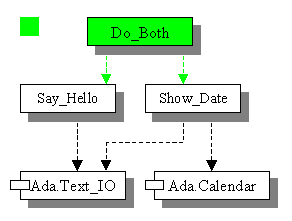[ Table of Contents ] [ Prev ] [ Chapter Overview ] [ Next ] [ Glossary/Index ]

|
In this example we employ the two preceding example programs
as reusable components known as library units.
Our main procedure, Do_Both, depends on these two library units. The Say_Hello and Show_Date procedures are user-defined library units, which
depend on the predefined library units shown at the bottom of the diagram. The
latter are library packages, the former are library procedures. |
Once the new main procedure, Do_Both, has been compiled, it too becomes a library unit,
which could be used again ("withed in") by another unit in another program.
Thus, the program depicted graphically above consists of five library units: two from the
predefined environment and three that have been user defined. In the next chapter you will
see that whenever a program unit is created it falls into one of two categories: it is
either a library unit or a nested unit.
Source Code Listing
----------------------------------------------------------
-- This program calls two library procedures to, first,
-- display the message "Hello" and, second, to find and
-- display the current date.
----------------------------------------------------------
with Say_Hello, Show_Date; -- with clause
procedure Do_Both is
begin
Say_Hello;
Show_Date;
end Do_Both;
----------------------------------------------------------
|
If you compile and link the above program and then run it on say, November 2, 2002, the
following lines of text should be displayed:
Hello
Today's Date:
Year = 2002
Month = 11
Day = 2
|
Note that there is only one with clause,
which names two withed in library units (our first two example programs). Their names are
separated by a comma. This is more compact, but equivalent to writing two separate with
clauses.
[ Back to top of page ] [ Prev ] [ Next ]
